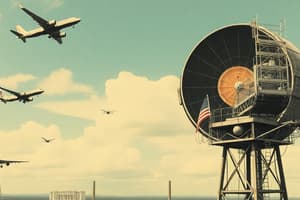Podcast
Questions and Answers
What tilt setting should be used during the descent phase to keep ground returns on the top of the ND?
What tilt setting should be used during the descent phase to keep ground returns on the top of the ND?
- 6 ° up
- 0 °
- 4 ° up (correct)
- 2 ° up
Ground returns are easier to distinguish from weather returns when the tilt is adjusted.
Ground returns are easier to distinguish from weather returns when the tilt is adjusted.
False (B)
What tilt setting can be used at an ND range of 160 NM before adjustment?
What tilt setting can be used at an ND range of 160 NM before adjustment?
-1 °
For flights above the water, there are no ground returns, allowing the flight crew to use __________ tilt settings.
For flights above the water, there are no ground returns, allowing the flight crew to use __________ tilt settings.
Match the ND ranges with their appropriate initial tilt settings:
Match the ND ranges with their appropriate initial tilt settings:
Why is it important to adjust tilt settings during the approach phase?
Why is it important to adjust tilt settings during the approach phase?
What should the tilt setting be for an ND range of 40 NM?
What should the tilt setting be for an ND range of 40 NM?
An average tilt value can be used for pilots with manual weather radar that has one tilt knob.
An average tilt value can be used for pilots with manual weather radar that has one tilt knob.
What is the purpose of the tilt function in the weather radar?
What is the purpose of the tilt function in the weather radar?
The tilt setting of the weather radar is affected by the aircraft's bank angle.
The tilt setting of the weather radar is affected by the aircraft's bank angle.
What should the flight crew do to avoid overscanning a storm cell?
What should the flight crew do to avoid overscanning a storm cell?
The _____ function helps regularly scan the area ahead of the aircraft.
The _____ function helps regularly scan the area ahead of the aircraft.
What can happen if the tilt setting is not correct for a storm cell at high altitude?
What can happen if the tilt setting is not correct for a storm cell at high altitude?
Match the weather radar controls to their primary functions:
Match the weather radar controls to their primary functions:
To obtain a correct display of a storm cell, the flight crew must use the tilt knob to point the radar beam to the most _____ part of the storm cell.
To obtain a correct display of a storm cell, the flight crew must use the tilt knob to point the radar beam to the most _____ part of the storm cell.
What types of particles may cause low reflectivity in a storm cell at high altitude?
What types of particles may cause low reflectivity in a storm cell at high altitude?
What does the 'blind alley effect' refer to?
What does the 'blind alley effect' refer to?
The attenuation effect makes it difficult to identify active storm cells due to weak signals behind precipitation.
The attenuation effect makes it difficult to identify active storm cells due to weak signals behind precipitation.
What is the purpose of using manual gain in weather radar analysis?
What is the purpose of using manual gain in weather radar analysis?
In weather radar displays, a black hole behind a red area indicates a __________ zone.
In weather radar displays, a black hole behind a red area indicates a __________ zone.
Match the radar features with their respective functions:
Match the radar features with their respective functions:
Which radar feature helps specifically in identifying heavy precipitation areas?
Which radar feature helps specifically in identifying heavy precipitation areas?
The A330 flight crew techniques manual suggests ignoring the 'black hole' signal behind a red area on weather radar.
The A330 flight crew techniques manual suggests ignoring the 'black hole' signal behind a red area on weather radar.
What should flight crews be cautious of when utilizing a short ND range?
What should flight crews be cautious of when utilizing a short ND range?
What can frequent lightning indicate during a flight?
What can frequent lightning indicate during a flight?
The TURB function on the weather radar detects areas of both wet and dry turbulence.
The TURB function on the weather radar detects areas of both wet and dry turbulence.
What is the minimum distance from a convective cloud to initiate an avoidance maneuver?
What is the minimum distance from a convective cloud to initiate an avoidance maneuver?
The area where the flight crew estimates that weather conditions are too dangerous to fly is called the ______.
The area where the flight crew estimates that weather conditions are too dangerous to fly is called the ______.
What is the recommended avoidance technique when encountering severe weather?
What is the recommended avoidance technique when encountering severe weather?
Match the terms with their meanings:
Match the terms with their meanings:
Avoidance of weather hazards always has a higher priority than avoiding detected weather.
Avoidance of weather hazards always has a higher priority than avoiding detected weather.
What should a flight crew remember about the capability of the weather radar?
What should a flight crew remember about the capability of the weather radar?
What should be preferred when avoiding convective clouds?
What should be preferred when avoiding convective clouds?
It is advisable to deviate downwind to avoid convective clouds.
It is advisable to deviate downwind to avoid convective clouds.
What should be used for a detailed analysis of the convective clouds?
What should be used for a detailed analysis of the convective clouds?
If the aircraft encounters ice crystals precipitation, the ______ procedures and recommendations apply.
If the aircraft encounters ice crystals precipitation, the ______ procedures and recommendations apply.
Which action should be taken if there are ECAM alerts related to engine stall?
Which action should be taken if there are ECAM alerts related to engine stall?
Match the ECAM alerts with their associated issues:
Match the ECAM alerts with their associated issues:
What should be done if necessary for a more precise analysis of weather conditions?
What should be done if necessary for a more precise analysis of weather conditions?
Paying attention to strong echoes below the aircraft is not necessary.
Paying attention to strong echoes below the aircraft is not necessary.
What is a primary reason that ice crystals are difficult to detect with weather radar?
What is a primary reason that ice crystals are difficult to detect with weather radar?
Ice detectors are effective in detecting ice crystals due to their solid state.
Ice detectors are effective in detecting ice crystals due to their solid state.
List one indication of ice crystals that may be observed during flight.
List one indication of ice crystals that may be observed during flight.
Flight crews should avoid flight into areas with a high concentration of __________.
Flight crews should avoid flight into areas with a high concentration of __________.
Which of the following is NOT an indication of ice crystals?
Which of the following is NOT an indication of ice crystals?
Ice crystals can cause significant icing of the airframe.
Ice crystals can cause significant icing of the airframe.
At what temperature does the aircraft TAT indication typically remain when flying in areas with ice crystals?
At what temperature does the aircraft TAT indication typically remain when flying in areas with ice crystals?
Match the following indications with their descriptions:
Match the following indications with their descriptions:
Flashcards
Blind Alley Effect
Blind Alley Effect
A course change that might seem safe at shorter ranges on weather radar, but is blocked by weather at longer ranges.
Weather Radar Tilt
Weather Radar Tilt
The angle between the radar antenna beam and the horizon.
Radar Antenna Stabilization
Radar Antenna Stabilization
The radar antenna uses data from the Inertial Reference System (IRS) to maintain a stable tilt angle, independent of aircraft pitch and bank.
Attenuation Effect
Attenuation Effect
Signup and view all the flashcards
Use of Manual Gain
Use of Manual Gain
Signup and view all the flashcards
Tilt Knob
Tilt Knob
Signup and view all the flashcards
Storm Shadows
Storm Shadows
Signup and view all the flashcards
Scanning the Area Ahead
Scanning the Area Ahead
Signup and view all the flashcards
Correct Tilt Setting
Correct Tilt Setting
Signup and view all the flashcards
Radar ND Ranges
Radar ND Ranges
Signup and view all the flashcards
Active Storm Cell
Active Storm Cell
Signup and view all the flashcards
Ground Return
Ground Return
Signup and view all the flashcards
High Altitude Storm Cell Ice
High Altitude Storm Cell Ice
Signup and view all the flashcards
Overscanning
Overscanning
Signup and view all the flashcards
Weather Radar Tilt Adjustment
Weather Radar Tilt Adjustment
Signup and view all the flashcards
Descent Tilt
Descent Tilt
Signup and view all the flashcards
Approach Tilt
Approach Tilt
Signup and view all the flashcards
Cruise Tilt Setting
Cruise Tilt Setting
Signup and view all the flashcards
ND Range
ND Range
Signup and view all the flashcards
Ground Returns
Ground Returns
Signup and view all the flashcards
Weather Returns
Weather Returns
Signup and view all the flashcards
Manual Tilt Mode
Manual Tilt Mode
Signup and view all the flashcards
Automatic Weather Radar
Automatic Weather Radar
Signup and view all the flashcards
Ice Crystal Detection
Ice Crystal Detection
Signup and view all the flashcards
Convective Cloud Hazard
Convective Cloud Hazard
Signup and view all the flashcards
Weather Radar
Weather Radar
Signup and view all the flashcards
Ice Crystal Icing
Ice Crystal Icing
Signup and view all the flashcards
Ice Crystal Indicators
Ice Crystal Indicators
Signup and view all the flashcards
TURB function
TURB function
Signup and view all the flashcards
Area of Greatest Threat
Area of Greatest Threat
Signup and view all the flashcards
Avoid Ice Crystal Areas
Avoid Ice Crystal Areas
Signup and view all the flashcards
Weather Hazard Prediction
Weather Hazard Prediction
Signup and view all the flashcards
Avoidance Priority
Avoidance Priority
Signup and view all the flashcards
Early Avoidance Maneuver
Early Avoidance Maneuver
Signup and view all the flashcards
Lateral Avoidance
Lateral Avoidance
Signup and view all the flashcards
Upwind Deviation
Upwind Deviation
Signup and view all the flashcards
Minimum Avoidance Distance
Minimum Avoidance Distance
Signup and view all the flashcards
Weather Radar Analysis
Weather Radar Analysis
Signup and view all the flashcards
Lateral Avoidance
Lateral Avoidance
Signup and view all the flashcards
Vertical Avoidance
Vertical Avoidance
Signup and view all the flashcards
Convective Clouds
Convective Clouds
Signup and view all the flashcards
Avoidance Margins
Avoidance Margins
Signup and view all the flashcards
Upwind Deviation
Upwind Deviation
Signup and view all the flashcards
Ice Crystal Precipitation
Ice Crystal Precipitation
Signup and view all the flashcards
Engine or Probe Misbehavior
Engine or Probe Misbehavior
Signup and view all the flashcards
ECAM Alerts
ECAM Alerts
Signup and view all the flashcards
QRH Procedures
QRH Procedures
Signup and view all the flashcards
Unreliable Airspeed Indication
Unreliable Airspeed Indication
Signup and view all the flashcards
Engine Vibration
Engine Vibration
Signup and view all the flashcards
Engine Relight in Flight
Engine Relight in Flight
Signup and view all the flashcards
Weather Radar Manual Modes
Weather Radar Manual Modes
Signup and view all the flashcards
Study Notes
Aircraft Systems - Weather Radar
- Weather radar uses water droplet reflectivity to detect weather
- Radar detects weather intensity based on droplet size, composition, and quantity
- Radar reflectivity scale ranges from high (red) to low (green)
- Radar does not detect clouds, fog, or clear air turbulence
Weather Radar Principle
- High reflectivity indicates wet hail, rain, wet snow
- Good reflectivity indicates liquid water
- Low reflectivity indicates fog, dry hail, dry snow, drizzle
Purpose of Weather Radar
- Helps flight crews detect and avoid storm cells
- Storm cell reflectivity varies with altitude due to decreasing liquid water content at higher altitudes
- Radar top is the upper detection limit, not the visible storm top
- Storm cells and turbulence extend significantly above the radar top
Manual Tilt Management
- Tilt is the angle between the antenna beam and the horizon
- Radar antenna is stabilized by the Inertial Reference System (IRS)
- Antenna tilt is independent of aircraft pitch and bank angle
Weather Detection
- Flight crew uses TILT, GAIN, and RANGE controls
- Common practice sets ground return at the top of the screen for correct storm display
- Overscanning occurs at high altitudes when the tilt is incorrect, showing only the upper part of the storm cell
Range Management
- Flight crew monitors long- and short-distance weather to avoid the "blind alley effect"
- At long distances, weather radar accuracy is lower due to wider beams and signal attenuation
Use of Weather Radar in Flight Phases
- Specific tilt settings are used for different flight phases (taxi, takeoff, climb, level flight, descent, approach)
- Adjustments are made to compensate for altitude changes and maintain ground returns at the top of the display
Weather Radar - Analysis of Storm Cell Expansion
- Vertical storm cell expansion assessment helps flight crew assess convective energy
- Formula is used to estimate cloud expansion above or below aircraft altitude(h(ft) = d(NM) x Tilt(°) x 100)
- d(NM) is the distance, and Tilt is the tilt angle for the echo to disappear
- Assessment can estimate the potential threat of a storm
- Colors do not directly indicate weather hazard, shapes and areas of concentration are used as an indicator
Interpretation of Weather Display Colors
- Particle reflectivity of the storm cell does not directly indicate threat
- High humidity areas, near the sea, results in higher reflectivity but may not indicate threat
- High vertical storm cell expansion is dangerous despite low reflectivity
- Equatorial areas may result in very low reflectivity, but high potential danger
Specific Weather Shapes
- Different colors near each other usually indicate areas of severe turbulence
- Shapes are a good indicator of severe hail and strong vertical drafts
- Shapes that change quickly indicate high weather activity
Attenuation Effect
- Strong reflectivity at the front of precipitation indicates heavy precipitation
- Behind precipitation, there are areas of low reflectivity (storm shadows)
- Attenuation of these signals helps differentiate very active storm cells
- Particular radars, like Collins and Honeywell, use the ND to help highlight areas of potential high attenuation
Use of Manual Gain
- To assess general weather conditions, Manual Gain can be used
- Manually adjusting gain helps in identifying areas of heavy rainfall within storm cells
- Automatically calibrating gain provides better standard display for weather detection
Radar Interference
- High-power external radio frequencies can interfere with radar
- Interference appears as a wedge on the display, broadening as it gets closer to the source of interference
- Interference disappears if the source is clear of the radar scan zone
Operations in Convective Weather
- Flight crew should use operational recommendations, knowledge of meteorology, and operation in adverse weather conditions
Weather Detection and Avoidance Decisions
- Convective clouds are dangerous even with weak echoes
- Frequent lightning indicates high turbulence probability
- "Area of greatest threat" should be established based on weather radar echoes
- Priority is given to avoidance of hazardous weather
Ice Crystals
- Ice crystals are solid water particles in clouds
- They can have adverse effects when in contact with high-temperature surfaces
- Detection of ice crystals can be difficult
- Areas of high ice crystal concentration should be avoided
Operational Recommendations for Ice Crystals
- Use weather radar to identify areas with strong echoes
- Pay attention to areas below the aircraft and downwind of strong echoes
- Use avoidance margins and lateral instead of vertical avoidance whenever possible
Ice Crystal Detection
- Ice crystals are difficult to detect with weather radar due to their low reflectivity and small size
- Indicators can include rain on the windshield, low aircraft temperatures, unusual ozone smells, and a lack of significant radar echo
- Strong convection clouds usually indicates high concentration ice crystals in areas above the cloud and potentially along with visible moisture
Studying That Suits You
Use AI to generate personalized quizzes and flashcards to suit your learning preferences.




